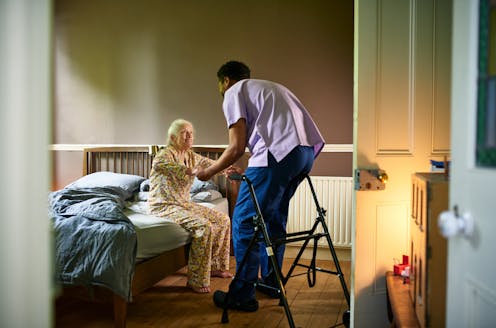
More than 80% of U.S. nursing homes reported staffing shortages in early 2023. SciLine interviewed Dr. Jasmine Travers, a gerontological nurse practitioner and assistant professor of nursing at New York University Rory Meyers College of Nursing, and asked her how the shortage affects health care for nursing home residents, if nursing homes in poorer neighborhoods have been hit harder by the shortages, and what can be done to fix the problem.
Below are some highlights from the discussion. Answers have been edited for brevity and clarity.
Who lives in nursing homes in the United States?
Jasmine Travers: There are 15,000 nursing homes with approximately 1.2 million residents. That population can range in age, although most commonly it’s those 65 years of age or older.
What is the current state of nursing home staffing?
Jasmine Travers: In 2001, the Centers for Medicare & Medicaid Services proposed minimum staffing standards. They indicated that total nursing hours should be 4.1 hours per resident per day. And that’s including the registered nurse, the licensed practical nurse and the certified nursing assistants. Only 25% of nursing homes were found to be meeting those total nursing hours in 2019.
How did the COVID-19 pandemic affect nursing home occupancy and staffing?
Jasmine Travers: Occupancy levels hovered at about 80% prior to the pandemic. During the pandemic, occupancy went down to a low of 67%. By the end of 2022, those levels had gone up to 72%.
Lower occupancy levels can be a significant issue. Higher occupancy brings in more revenue to the nursing homes. With lower occupancy and less revenue coming in, then that’s a decrease in financial support that the nursing home needs to run their day-to-day activities.
How does nursing home staffing affect the quality of care and health outcomes for residents?
Jasmine Travers: A number of studies show that when staffing is low, emergency hospitalization visits increase. Some of these visits could have been addressed by care provided in the nursing home setting. We also see increased instances of pressure ulcers, urinary tract infections, falls and deficiency citations – issued when a nursing home does not meet a certification minimum standard.
When nursing homes are understaffed, that means there might not be a sufficient number of certified nursing assistants to, for example, answer call bells. That might translate to residents sitting in their beds needing help for longer periods of time.
In those instances, if a person doesn’t have someone to get them out of bed, sometimes they might try to get up themselves. And when they do that, they could be at risk of falling. Or if they stay in bed and they’re soiled, they’re at increased risk for urinary tract infections or pressure ulcers.
What can be done to alleviate nursing home staffing challenges?
Jasmine Travers: Areas that are socioeconomically deprived or that lack good transportation, housing and schools are less desirable places to work.
Just recently, the Centers for Medicare & Medicaid Services released an announcement that they are going to allow for those in pediatric specialties to receive loan reimbursements and loan forgiveness for working in underserved areas. A similar program for those working in nursing homes would likely increase staffing.
I’d also like to see improved wages and benefits and more investment in retention efforts to keep the people who are already working in nursing homes working there.
One of the biggest issues when it comes to staffing is turnover. People will stay when the work environment is changed. And when people stay longer, they know their residents more. That consistency translates to better quality of care.
Watch the full interview to hear more.
SciLine is a free service based at the nonprofit American Association for the Advancement of Science that helps journalists include scientific evidence and experts in their news stories.
Jasmine Travers receives funding from Robert Wood Foundation and the National Institutes of Health.
This article was originally published on The Conversation. Read the original article.







